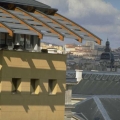The Limestone Block throughout History
The "dead cities," as they used to be called, in northern Syria constitute one of the most wonderful archeological sites in the world. They consist of over 700 sites from the Roman and Byzantine periods and extend on a wide region between Turkey in the north, Apamia in the south, the Efrin and Orontes valleys in the west and the Aleppo plain in the east. They also occupy a number of limestone mountains called the "limestone block". The surface area of this block is about 2,000 square kilometers: the Simeon and Halaqa mountain in the north, Barisha and A'ala in the middle and the Zawiya in the south.
The significance of these sites does not lie in their number but in rather in its rural nature: they are not cities but old villages surrounded sometimes by stone walls forming cadastrals networks from the Roman period. The civilizations which date back to the end of the old ages are definitely urban civilizations, but they relied on the base formed by the rural areas in which the vast majority of people lived and worked and which essentially determined the level of their wealth. The villages and rural areas of the Roman and Byzantine periods are not well known: the sources of the texts are city dwellers who did not know them very well, in addition to the fact that their remains are largely destroyed. But the case is the exact opposite in northern Syria, where these ruins have been exceptionally preserved. The villages which are better preserved are often in full integrated groups.
Melchior de Voguë had explored and identified the ruins of the limestone blocks in the nineteenth century. They were explored again by Butler in the period 1901 – 1910. They are credited with the major writings which constitute a wealth of documentation. G. Tchalenko is credited with raising these issues on the historical level in the period 1934 – 1975 through the ruins of village not of cities. New studies have been sponsored by the French Institute for Near East Antiquities on temples, churches, tombs, pressers, baths and houses using new and innovative programmes in geography, geology and soil sciences. The studies also focused on climatic and environmental aspects. Two archeological missions were initiated: one in the northern mountain series in Dahes, and the other in Serjila in the Zawiya mountain. As of 1994 the mission has become a joint Syro-French mission which allowed for enhancing cooperation with the Department of Museums and Antiquities, in the framework of real scientific partnership, with the launch of new excavations in al-Bara and the preparation of an archeological map with a geographical frame of reference.
The first question asked about this large archeological group is related to how it existed and was preserved in a dry region while no trace of it remained on the neighbouring plains. This paradox is explained by the fact that the villages on the plains continued to be inhabited and the houses were continuously renovated, while immigration from the villages of the limestone blocks as of the eighth century and the toughness of the stone houses allowed for their survival.
These villages had been built and inhabited by peasants who came from neighbouring plains. They were called "Syrians" because of Aramaic names of persons and places. Afterwards, those peasants learned Greek which was the language of the ruling classes and the urban elite for a thousand years - from the invasion of Alexander until the Arab-Islamic conquest of the region.
As of the first century BC, those peasants preferred to climb the slopes in order to farm the difficult land of the mountain when land was becoming scarcer in the plains because of population growth encouraged by Pax Romanica (between the 1st and 3rd centuries) then Pax Byzantina (between the 4th and 6th centuries). Thus, they prepared fields for changing a rough mountain into real country. They also became stone cutters, builders and quarry workers in order to improve their income during the dead season of the year. As of the 5th century, and although the population was growing, their wealth increased when they started producing olive oil, wine, fruit and meat and selling these products in the markets of the neighbouring villages and towns. This quick rise was interrupted, however, in the period 540 – 550, i.e. a century before the Arab –Islamic conquest: the population continued to grow unlike resources, which led to crises and epidemics aggravated by malnutrition. The population became poorer but without any decrease in their number. When the Omayads state started to decline, the peasants started to descend to the plains leaving lands in more fertile areas. By the 10th century the villages had been completely deserted.
The dead cities are of exceptional importance because they give us an accurate picture of about 2,000 square kms of rural areas towards the end of the middle ages, whereas most of remaining ruins from that period are those of cities. Studying them also reveals something unknown before, namely that villages in non-arable land, and despite the tolls imposed by the state and powerful land owners, could have been populated by wealthy village.

















